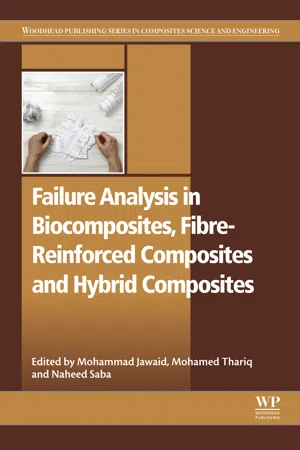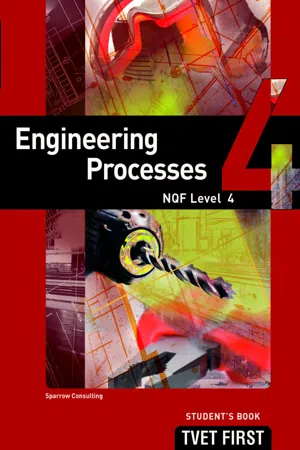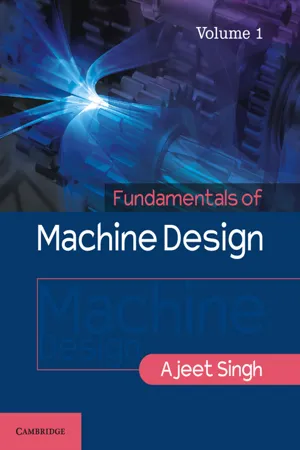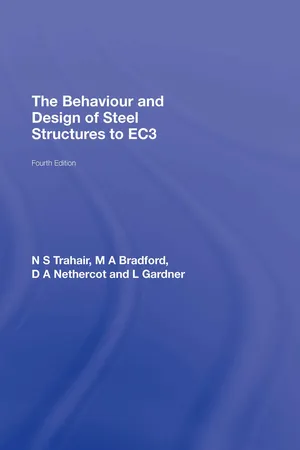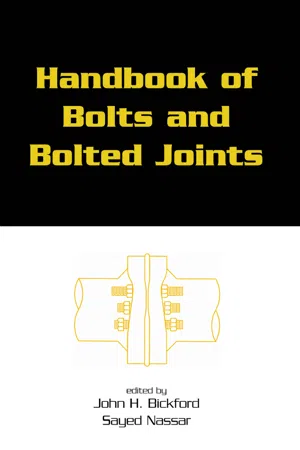Technology & Engineering
Bolted Joint
A bolted joint is a mechanical connection between two or more components using bolts and nuts. It is a common method for fastening and securing parts in various engineering applications. The joint relies on the clamping force generated by tightening the bolts to hold the components together.
Written by Perlego with AI-assistance
6 Key excerpts on "Bolted Joint"
- Mohammad Jawaid, Mohamed Thariq Hameed Sultan, Naheed Saba, Mohamed Thariq(Authors)
- 2018(Publication Date)
- Woodhead Publishing(Publisher)
Bolted Joint is one of the techniques that are used to connect materials together to form mechanical structures. In comparison to adhesive bonding and welding methods, Bolted Joint has been widely used due to its high load-carrying capacity, ease of assembly, and relatively low cost. Bolted Joint comprises bolt, nut and washer to perform its clamping purpose. Their joint integrity is governed by the quantitative representation of the contact pressure distribution at the joint interface. Single and double lap joints are those of the most common form of mechanical joints. Fig. 4.2 shows the typical forms of single and double mechanical lap joints. Although the joining process is the important step to connect two different parts to produce a construction, the joints are generally the weakest points of the structures that determine their stability. For example, the joints have been the weakest point in the airframe that determines the structural efficiency [21]. Apart from the aerospace application, Bolted Joints are also required for railway tracks to assemble the rail segment during installation. Nevertheless, the rail joints are also the weak points on the rail track, consequently leading to the short service life. The failure of the joints is generally associated with bolt loosening, cracked bolts, and cracked joint bars, which result in disrupting railroad operation, and sometimes the joints fail catastrophically. Bolt loosening is always the most common problem to occur for the Bolted Joint. Theoretically, it is possible to provide a proper design to produce a Bolted Joint that can overcome the unintentional bolt loosening [22]. However, the cyclic load during their service life causes the loosening of Bolted Joints- eBook - PDF
Engineering Processes NQF4 SB
TVET FIRST
- Sparrow Consulting(Author)
- 2013(Publication Date)
- Macmillan(Publisher)
Bolted Joints are semi-permanent. Advantages They are reliable and provide a strong connection • They can be disassembled without damaging the parts involved • They do not cause any change to the • microstructure They require little or no preparation • They can be used to join parts made of different materials • They can be stronger than welds. • Disadvantages Enough space must be available to use a spanner to fasten the bolts • or nuts Using them is labour intensive • They add weight to the machine. • Threaded: A threaded shaft has uniform, spiral grooves machined into its surface. Washer: Is a thin, disk-shaped plate with a hole through its centre. A washer is wider than the nut it is used with. Microstructure: The microscopic structure, at molecular levels. Words & Terms 232 Module 16: Identify different joining systems and select appropriate methods Screw joint Screws have a round stem, known as the body, with threads cut into one end, and a head. The head is specially shaped to allow a screwdriver to rotate the screw, driving it in or releasing it. A bolt is sometimes referred to as a screw if it used without a nut. The head is of larger diameter than the body of the screw so that the screw cannot be driven deeper than the length of the shaft, and to provide compression between the workpieces being joined. Screws are used when the parts to be fastened together have threaded holes in them (in some cases the screw can create its own threaded hole e.g. a self-tapping screw). A screw works on the same principle as the bolt and nut connection but instead of tightening with the nut, the thread grips onto the parts to be fastened together as the screw is driven in with a screwdriver. Unlike bolts, screws can be used in places inaccessible to spanners. - eBook - PDF
- Andrew Samuel, John Weir(Authors)
- 1999(Publication Date)
- Butterworth-Heinemann(Publisher)
Relate your abstract approach to real-life examples by making a second (very schematic) sketch of each of the ten fasteners you included in your list in (d), above, and applying your system of symbolic representation to it. 4.2 Bolted Joints and screws- design for clamping contact It is commonplace to think ofbohedjoints in terms of one or more bolts holding some components together. However such a definition is too loose for our purposes. In this book we regard Bolted Joints to be a subset of clampedjoints (see Figure 4.7 in the previous section), so the bolts must perform a more specific task than merely linking the connected components. A bolt that merely links adjacent components without ensuring any appreciable clamping force between them is properly classified as either a shear connector (pinnedjoint), or perhaps a tensile link, and may be designed according to the methods of Section 4.3 or 3.4.2, as appropriate. 196 I ~ In order to qualify as a boltedjoint in the terms of this present section, the bolts must maintain a minimum clamping contact force between the parts being joined. Furthermore, they must continue to clamp the joint with at least this required contact force, when the external loads (those tending to separate the joint) vary through their full load cycle. Not surprisingly, a Bolted Joint consists of a tensile element that we refer to as a bolt, and special connection regions on the two components being connected. These connection regions come in various shapes, but always possess a contact surface (where the compressive contact, or sealingforce, is transmitted against the partner component), an anchor point to the tensile element, and some stressed material between the contact surface and the anchor point. These rather abstract terms are illustrated in Figure 4.8. - eBook - PDF
- Ajeet Singh(Author)
- 2017(Publication Date)
- Cambridge University Press(Publisher)
Outcomes Learn about the joints made by using bolts and nuts Advantages and disadvantages of Bolted Joints Classification and profiles of different types of threads Pitch of threads, their designation, and specifying a thread Bolt/nut materials and their manufacturing Various types of locking devices for Bolted Joint Difference between bolt and screw, and different types of screws Types of threaded joints using a bolt or a stud Initial stresses and stresses developed due to external forces in a threaded joint Turn buckle and its design procedure Bolts of uniform strength Design of cylinder cover joint Stiffness of bolt and components forming a Bolted Joint Load sharing by bolt and components Maximum load on a bolt Effect of hardness of a gasket in the design of a Bolted Joint Specifying a bolt with its class and its endurance strength Design procedure for variable loading C H A P T E R 16 Bolted Joints Fundamentals of Machine Design, Volume I 472 16.1 Introduction All machines are composed of many parts, which are joined together by some type of joint. The joint may be permanent like riveting or welding, or detachable using bolts and nuts. The latter provides the advantage that the parts can be separated, whenever required, without damaging the joint. Bolt and nut are mostly used for such joints. Standardization of such widely used components is necessary for interchangeability. A bolt or screw is a type of fastener having a helical ridge wrapped around a cylinder, known as an external thread. The cylindrical portion of the screw from the underside of the head to the tip is known as the shank; it may be fully threaded or partially threaded (Plate 16.1). Some threads mate with a complementary thread, known as an internal thread of a nut, which is a machine part having internal threads formed into it. Other screw threads are designed to cut a helical groove in a softer material as the screw is inserted, for example, wooden screw. - N.S. Trahair, M.A. Bradford, David Nethercot, Leroy Gardner(Authors)
- 2017(Publication Date)
- CRC Press(Publisher)
Each com- ponent is then proportioned so that it has sufficient strength to resist the force that it is required to transmit. General guidance on joints is given in [2–11]. 9.2 Joint components 9.2.1 Bolts Several different types of bolts may be used in structural joints, including ordinary structural bolts (i.e. commercial or precision bolts and black bolts), and high- strength bolts. Turned close tolerance bolts are now rarely used. Bolts may transfer Joints 393 Bolt forces Bearing Bearing Bearing Shear Shear (a) Shear and bearing joint (b) Preloaded friction-grip joint (c) Tension joint Bearing Bearing Bolt forces Tension Bearing Bearing Bearing Friction Friction Friction Plate forces Figure 9.1 Use of bolts in joints. loads by shear and bearing, as shown in Figure 9.1a, by friction between plates clamped together as shown in the preloaded friction-grip joint of Figure 9.1b, or by tension as shown in Figure 9.1c. The shear, bearing, and tension capacities of bolts and the slip capacities of preloaded friction-grip joints are discussed in Section 9.6. The use of bolts often facilitates the assembly of a structure, as only very simple tools are required. This is important in the completion of site joints, especially where the accessibility of a joint is limited, or where it is difficult to provide the specialised equipment required for other types of fasteners. On the other hand, bolting usually involves a significant fabrication effort to produce the bolt holes and the associated plates or cleats. In addition, special but not excessively expensive procedures are required to ensure that the clamping actions required for preloaded friction-grip joints are achieved. Precautions may need to be taken to ensure that the bolts do not become undone, especially in situations where fluctuating or impact loads may loosen them. Such precautions may involve the provision of special locking devices or the use of preloaded high-strength bolts.- No longer available |Learn more
- John Bickford(Author)
- 1998(Publication Date)
- CRC Press(Publisher)
23 Behavior of a Bolted Joint During Assembly JOHN H. BICKFORD Consultant, Middletown, Connecticut 1. INTRODUCTION Many different assembly tools and procedures are discussed in this section of the Handbook. Some of these will seem overly complicated to those who don't appreciate the complexity of Bolted Joints. In this chapter we examine the behavior of the joint during assembly, introducing many of the factors that make it difficult to do a perfect'' job with even the most sophisticated tools and procedures. That all-important clamping force that holds the joint together-and without which there would be no joint-is not created by a good joint designer or by high quality parts. It is created by the mechanic on the assembly line or job site, using the tools, procedures, and working conditions he or she has been provided with. The force is brought into being as energy in the mechanic or power tool is converted to potential energy stored in the joint and bolt members. The correct amount of force cannot be created if the design is faulty or the parts don't fit together properly or if they break; but getting all this right, while necessary, is not enough. The final, essential creator of the force is the mechanic, and the time of creation is during assembly. So it is very important for us to understand the assembly process. How do the bolts and the joint members respond as we tighten the bolts? We will see that the behavior of the parts during assembly is complex. This chapter takes a close look at several unseen, difficult to detect, difficult to quantify factors that can have a significant impact on the results, on the amount of clamping force developed in the joint. This will teach us that it isn't easy to control the buildup of clamping force in the joint and that mechanics need all the help we can give them, both as product designers and as production engineers.
Index pages curate the most relevant extracts from our library of academic textbooks. They’ve been created using an in-house natural language model (NLM), each adding context and meaning to key research topics.
